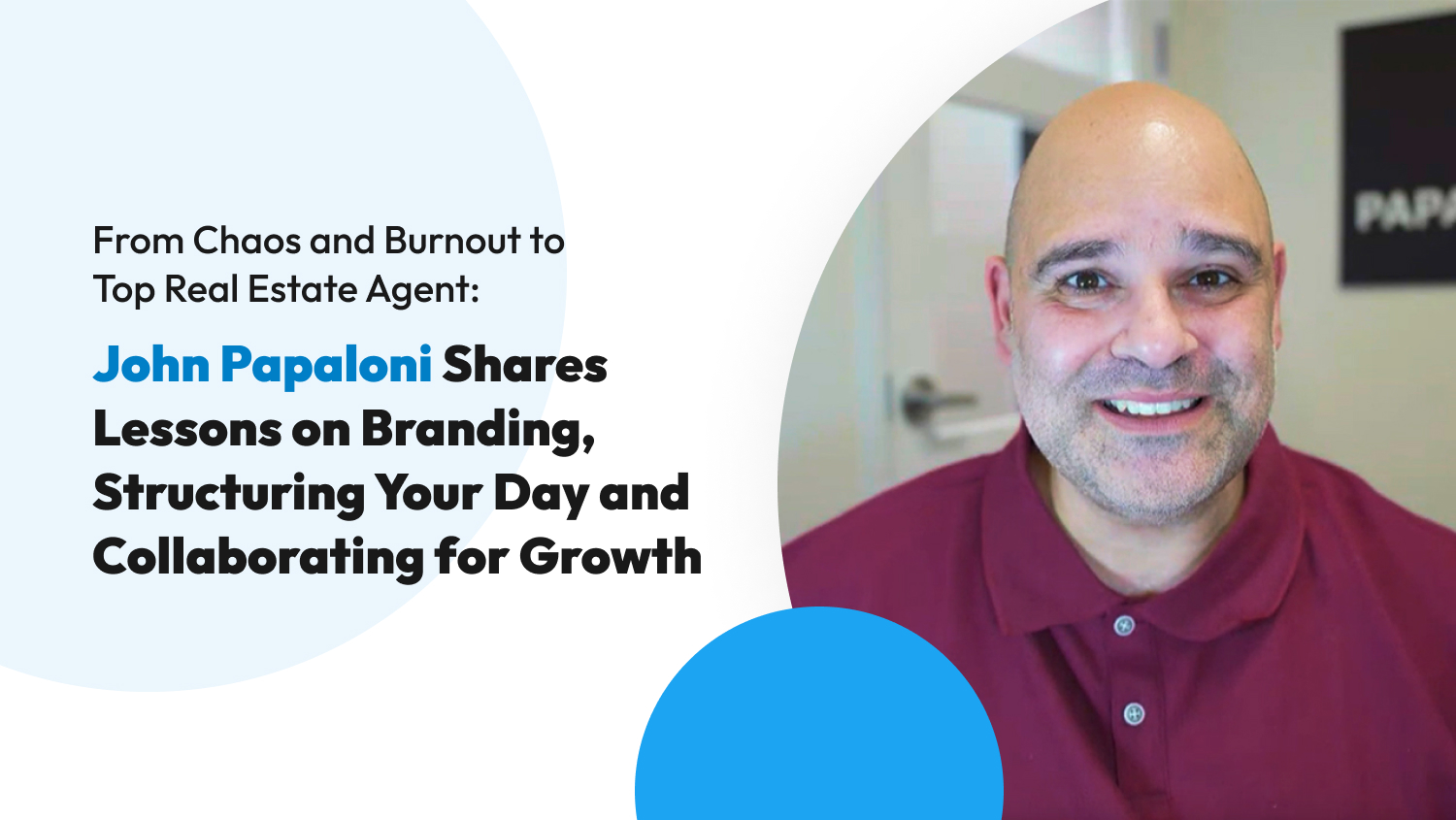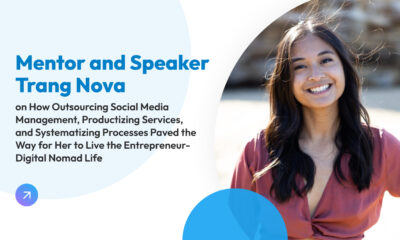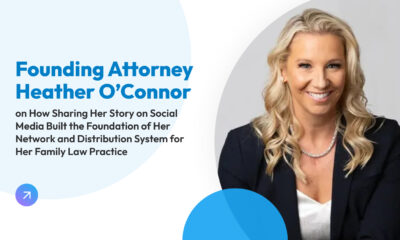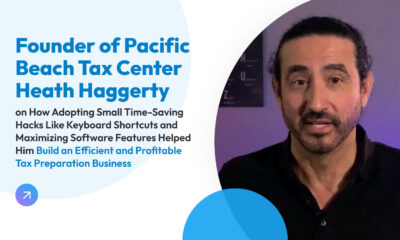Case Study
From Chaos and Burnout to Top Real Estate Agent: John Papaloni Shares Lessons on Branding, Structuring Your Day and Collaborating for Growth
John Papaloni was no beginner in business, having started, run and sold various ventures since he was 15 years old. But when he tried his hand at real estate in 2016, he struggled for over a year to find clients, close deals and get his business to a sustainable level. He had to overhaul his approach and find a way to reach his target market. Let’s take a look at the challenges he overcame and the tools and insights that have helped him along the way. Don’t forget to check out the end with a summary of Papaloni’s Productivity Stack Quick Reference.
Table of Contents
- Starting
- Growing
- Challenge 3: Distribution and Mind Share: How to build a brand people know, like and trust?
- Challenge 4: How to get out of a rut, plateauing and not growing your market
- Challenge 5: Delegation: How do you decide what to outsource and delegate?
- Challenge 6: Delegation: How do you find the right talent for the job
- Scaling & Success
- Hindsight: What Papaloni would have done differently
- Thoughts on Leveraging Social Media, Email Marketing, Self Care and Continuous Learning
- Wrap-up
- Papaloni’s Productivity Stack Quick Reference
- More about John Papaloni
Starting
Challenge 1: Reality vs Expectations – How to break through in a saturated business
Papaloni admits to having grandiose expectations in his first year as a real estate agent. He thought, “All my friends are going to buy, I’m going to have like 20 sales in my first month and I’m going to go crazy. The reality of it is, the majority of people you know will not use you when you are new. They want to see how you do before they feel confident.”
He cited Ontario statistics that 80% of agents sell 0-1 properties in a year, only 15% of agents make a living, and just 5% create wealth. A stark difference from the flashy cars and fancy lifestyle commonly associated with estate agents. Papaloni tried different things and was able to generate just two sales in his first year. Technically, he beat the average, but it was not even self-sustaining.
“I was like everybody else – chaos. No real written plan, trying everything and anything and watching everything flop.” By the middle of his 2nd year, not much in his business situation had changed. Papaloni realized he had to make a ‘game plan’ to stop wasting time on things that don’t bring in income.
Solution: He came up with a structure for his day to day to focus on income-producing activities or IPA. “When I started developing structure, everything started to change.” He talks about a morning routine and making sure you have two hours of IPA each day. These IPAs included consistent posting on social media and dedicating time for client/prospect outreach – through replies on social media or calls.
People: Papaloni
System: Time blocking for client prospecting, Batching social media content production, repurposing content across different platforms
Tools: Google Calendar, Notepad or notebook for note-taking like Moleskin, Instagram, Facebook, LinkedIn, YouTube, TikTok, Twitter, Canva, Adobe Premiere Pro, Final Cut Pro, iMovie, iPhone to consistently post through the day
Challenge 2: How to deal with burnout
But the tough start took its toll on Papaloni. He was extremely driven in the beginning and he took care not just of his prospects but other agent’s clients as well. He showed 4,200 houses in his first 18 months! “I was fed up, I had enough, and I literally suspended my own license.”
Solution: He took a hiatus, during which time he purchased his own house. And because he had suspended his license, he had to get a realtor friend to work on the transaction with him. The process of acquiring his own home and the negotiations fired up his passion for working in real estate again. After 90 days on hiatus, he was ready to get back in the business. “I knew that the break was all I needed. I went right back into it and I’ve been strong ever since.”
People: Papaloni, realtor friend
System: Intentional time away from the business to recharge
Tools: Zoom
Growing
Challenge 3: Distribution and Mind Share: How to build a brand people know, like and trust?
Papaloni’s first couple of years as an agent drove home the importance of establishing credibility, gaining trust and forming a relationship with clients and prospects. “You’ve got to go beyond just the content. At the end of the day, everybody wants to deal with somebody they know, like, and trust.”
Solution: Papaloni focused on providing value through free educational content that addresses clients’ common concerns. He would write down questions clients and prospects asked during meetings and use these ideas for his podcast. He edits these into shorter videos and reposts on other platforms. Sometimes if the client call is via zoom, he will just take a clip of his response to the client and post it to social media.
He made it a point not to include a sales pitch in his content but instead nurture relationships with prospects and clients through regular check-ins that aren’t sales-oriented. Anyone who liked, shared, commented, sent a direct message, emailed or called the office – he got in touch with them from 3:00 – 5:00 pm every day. And he would schedule these regular catch ups every 90 days or so. Content can get you views and likes, but it is connecting with the audience and getting them engaged that creates warm leads for the business.
People: Papaloni, video editors
System: Time blocking for connecting with clients/prospects, Batching social media content production producing one month’s content at a time, repurposing content across different platforms
Tools: Google Calendar, Notepad or notebook for note-taking like Moleskin, Instagram, Facebook, LinkedIn, YouTube, TikTok, Twitter, Canva, Adobe Premiere Pro, Final Cut Pro, iMovie, iPhone to consistently post through the day, Hubspot, KiTS
Challenge 4: How to get out of a rut, plateauing and not growing your market
Papaloni continued with his routines and his social media strategy. But he admits he was not very strict in keeping to his time blocks. “Everything was planned out, but very flexible.” For example he would have two hours from 11:00-1:00 pm for IPA in his schedule, but when a client asked him out to lunch, he would say yes.
By his 3rd year, Papaloni noticed that he hadn’t really grown his market or found his niche. He felt like he was just doing the same thing, and getting the same results. He was at a loss about what to change, and self-doubt started to creep in.
Solution: He hired a coach to get him out of this rut. He spoke to at least three coaches before deciding on the one he felt was the best fit. When he came across someone he knew from the industry and whose podcast he used to follow, he knew he found the coach he needed. “From the minute we picked up the phone to the minute we hung up, everything clicked and jived.”
He worked with this coach for a year. They focused on setting up his systems and getting him disciplined with his routine to become more productive. Papaloni won an award for top sales in his brokerage during that year of coaching.
People: Papaloni, business coach
System: Thorough interview and selection process for a coach
Tools: Phone and Zoom for interviews and meetings with potential coaches
Challenge 5: Delegation: How do you decide what to outsource and delegate?
There is a tendency for a solopreneur to take on as many tasks and roles as possible to minimize costs. While Papaloni was used to delegation and working with teams from his prior business experience, he had to learn a new system of how to implement this in his real estate business.
Solution: He learned to quantify the value of his time – “You’ve got to actually put a dollar value on everything.” For example, the average commission on a home sale is $9,000, and it takes 40 hours with a client to achieve this sale. That means every hour of his time is equivalent to $270 in revenue. If he can get someone else to take over tasks like video editing for $30 an hour, then it makes complete sense to do so. His rule of thumb is 30% of sales is allocated to marketing – which includes video editing, Facebook ads, print ads, 30% for operations, 30% is payment to self and 10% is for an emergency fund.
He highlights that this of course has to be balanced in the context of what stage your business is in. You cannot spend on outsourcing what you are not yet earning in revenue. First you delegate tasks you like the least, and eventually, as you grow, you can delegate more.
People: Papaloni, accountants
System: Cost benefit analysis for outsourcing various tasks/roles
Tools: Wave Accounting for media company, Spreadsheets like Google Sheets
Challenge 6: Delegation: How do you find the right talent for the job
Delegation comes with its own challenges. Some freelancers or people you hire will not deliver work to your standards. “Finding people you like, that is the process. It’s not easy… But you’ve just got to find the style you like.”
Solution: Papaloni casts a wide net in searching for the right people. Locally, he scouts students who are looking for internships (called co-operative education students in Canada), and after training, they could transition to part time or full time work with him. He also uses LinkedIn and Indeed to advertise job openings. On Fiverr, he gets a few candidates to bid on a project so he can compare their pitches. “But more than likely, you can ask your colleagues or people in the business that have people they use as well, and they’ll just give you references. So that’s also another good way to do it.”
People: Papaloni, freelancers/interns, network
System: Training interns, Bidding process for freelancers, Asking for referrals from your network
Tools: Indeed, LinkedIn, Fiverr, Google Drive
Scaling & Success
Challenge 7: Collaboration: How to scale without setting up an agency
Papaloni had the opportunity to build his own agency and have a team of realtors working for him, but he didn’t want to go this route. He wanted a way to get help in showing houses without setting up a brokerage which he thinks can be too restrictive on agents.
Solution: Papaloni’s abilities to network, build and nurture relationships came into play. Taking an idea from another colleague in the industry, he created an arrangement where he partners with agents who will do the legwork of showing houses and regular communication with clients, while he brings in the leads and takes care of negotiations and offers. He and the partner agent agree on a commission split on any transactions done with the same client, regardless of what brokerage Papaloni or the partner agent work with.
This arrangement has several benefits: 1) He gets help with the tasks he likes the least, i.e., showing houses. 2) He maintains ownership of his leads or clients database, instead of needing to hand them over to another agent as business grows. 3) Clients get premium service because they effectively have two agents supporting them. 4) The arrangement became another source of leads, because partner agents would sometimes refer clients they cannot service or are out of their area. 5) The partner agents feel this is a fairer set-up because Papaloni doesn’t take any commissions from their own leads or clients.
Papaloni is a huge believer in practicing collaboration and an abundance mindset. “If you stop looking at people as competition and find ways to collaborate with them instead, you guys can grow bigger as a team working together than you can trying to be apart from each other, trying to hit each other out of the park. There’s growth in collaboration.” We see this collaborative approach in him tapping his network for referrals for his job openings and partnering with agents for client services. He even invites other real estate agents to guest on his podcast and share their unique perspectives on the industry and market.
People: Papaloni, partner agents
System: Flexible arrangement with other agents that is a win-win for both parties, Regularly connecting with network and referrals
Tools: Google Calendar, Instagram, Facebook, LinkedIn, YouTube, TikTok, Twitter, KiTS, Commission Agreement
Hindsight: What Papaloni would have done differently
Papaloni talks about overcoming hesitation and self-doubt. “Thing is that we all hesitate. Write what you want, figure out the steps you need to do and just do it.” You may be thinking of starting a podcast or making content to build your business—there’s no need to overcomplicate by thinking about expensive equipment and thinking of excuses to procrastinate. Just get started, be consistent and be disciplined about your routines. “Never let anybody disrupt your own appointment with yourself.”
Thoughts on Leveraging Social Media, Email Marketing, Self Care and Continuous Learning
Papaloni has some tips on building your brand on social media. “If you can’t be on all of the platforms, it’s not something you can commit to, pick your top two. Be on them every single day, be consistent.” He also thinks email marketing is still very useful. Click rates may not be as high as they used to be, but you know that subscribers are warm leads who are interested in your product or services.
On routines and schedules, Papaloni is an advocate of starting your days early, before everybody else wakes up to get a lot of things done. “You don’t have to start working, it can be as simple as taking care of yourself.” He suggests devoting some time in the morning for self care, through physical exercise, a good breakfast, or taking care of the mind through reading and podcasts. He doesn’t recommend starting your day opening emails. “You should have already been sitting down for an hour at work, getting your day started before you even check that.”
He believes skills, tools and systems are all equally important, and he would not have achieved his success without blending them all together. What good are top-of-the-line tools if you don’t have the skills to use them, and what good are your skills without the tools to execute them with? “The thing is, you can always learn new skills. So if you’re willing to learn, there’s always hope.”
Wrap-up
Papaloni’s journey highlights how different challenges can be across industries. In spite of many years of business experience, it took him some time to learn how to stand out in the real estate space, how to focus his efforts on productive activities as a solopreneur/agent and ultimately how to operate from a collaborative standpoint to create more opportunities for himself and his peers. His consistency in his social media presence, commitment to his daily IPA activities, and networking with his peers unlocked a bigger stage for him and are part of his success formula to date.
Today, he shares what he learned about building a brand and leveraging systems through Papaloni Media. This latest venture, established in 2019, offers social media marketing, podcast services and one-on-one or group coaching for entrepreneurs and businesses looking to grow their following, generate more sales and scale effectively.
Papaloni’s Productivity Stack Quick Reference
Starting Stack
- Google Calendar
- Notepad or notebook like Moleskin for note taking during client meetings
- YouTube
- TikTok
- Canva
- Adobe Premiere Pro
- Final Cut Pro
- iMovie
- iPhone
- Zoom
Growing Stack
Scaling & Success Stack
More about John Papaloni
“Serial Entrepreneur, From Bust to an 8 Figure Business and Repeat. I have gone through the ups and downs of entrepreneurship and have created several businesses, some were sold to other entrepreneurs, some were just closed.
I am currently CEO of Papaloni Media & Papaloni Capital with an Active Realtors License. I use my realtors license for my own acquisitions. I help aspiring entrepreneurs and real estate agents build systems and platforms to get them to the next level.”
You can find him on:
Instagram: www.instagram.com/johnpapaloni
Website: www.papalonimedia.com












